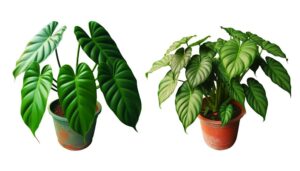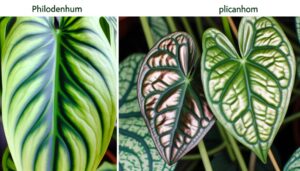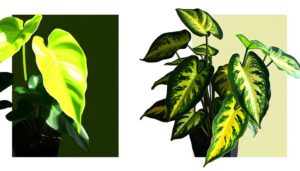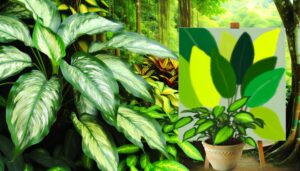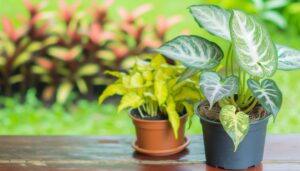Philodendron Elegans Vs Tortum: A Detailed Comparison!
Philodendron elegans and Philodendron tortum, both originating from South American rainforest understories, exhibit distinctive morphological traits. P.
elegans features deeply lobed, feather-like leaves, while P. tortum presents narrow, elongated, lace-like foliage.
Elegans climbs with robust leaves, requiring trellises, contrasting with the spreading growth and thread-like divisions of Tortum. Both require bright, indirect light and thrive in high humidity.
Elegans benefits from more frequent watering and higher humidity, whereas Tortum tolerates slight drying. Their pest susceptibilities and fertilizing needs vary, with Elegans favoring a balanced NPK fertilizer and Tortum benefiting from higher phosphorus.
For a detailed understanding, explore their specific care needs further.
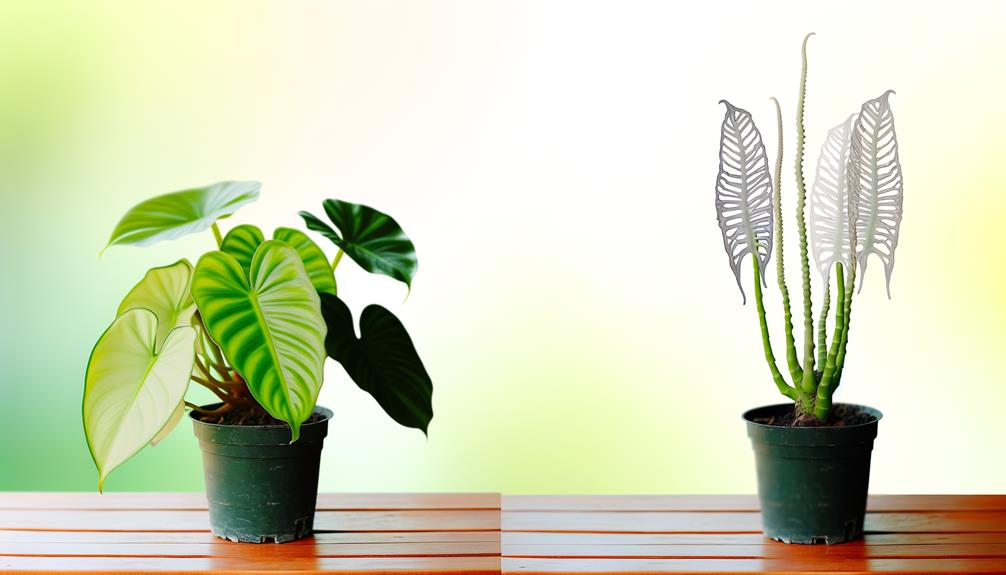
Comparison of Philodendron Elegans and Philodendron Tortum
| Feature | Philodendron Elegans | Philodendron Tortum |
|---|---|---|
| Scientific Name | Philodendron elegans | Philodendron tortum |
| Leaf Texture | Smooth, glossy | Smooth, glossy |
| Leaf Shape | Deeply lobed, fern-like | Deeply cut, resembling palm leaves |
| Leaf Color | Dark green | Dark green |
| Growth Habit | Climbing, vining | Climbing, vining |
| Mature Size | Medium-sized | Medium to large, can grow quite large |
| Light Preference | Bright, indirect light | Bright, indirect light |
| Watering Needs | Moderate, allow topsoil to dry between waterings | Moderate, allow topsoil to dry between waterings |
| Temperature Tolerance | Prefers warmer temperatures | Prefers warmer temperatures |
| Humidity Preference | Moderate to high | Moderate to high |
| Common Uses | Indoor houseplant, decorative | Indoor houseplant, decorative |
Origins and Natural Habitat
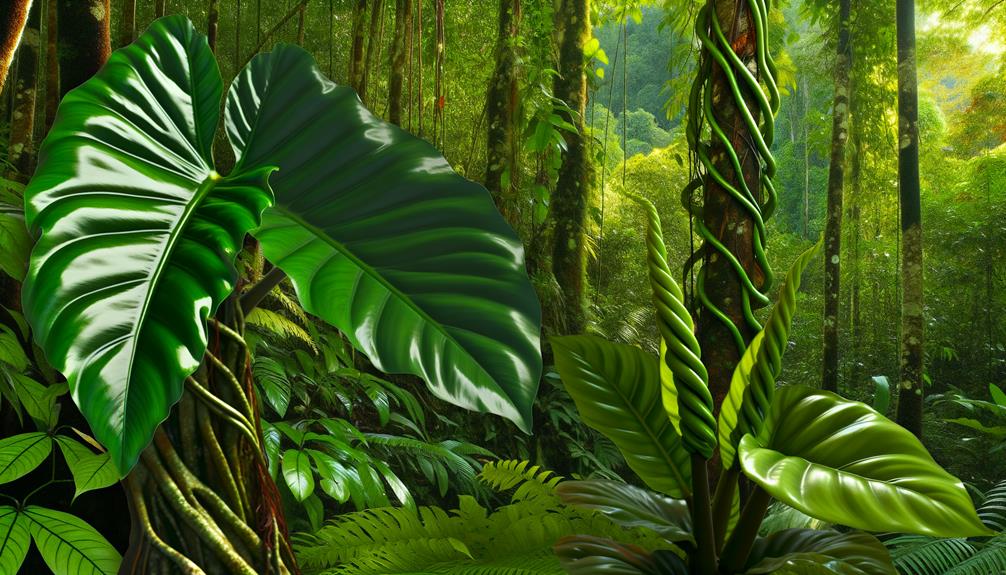
Philodendron elegans and Philodendron tortum, both members of the Araceae family, originate from the tropical rainforests of South America, where they thrive in the humid, shaded understory. These epiphytic and hemiepiphytic plants exhibit adaptations to their native environment, such as aerial roots for anchorage and nutrient absorption.
The rainforest’s consistently high humidity and diffused light conditions favor their growth, promoting lush, green foliage. P. elegans tends to be found in more lowland regions, whereas P. tortum is often located in slightly higher elevations. Both species benefit from the nutrient-rich detritus of the forest floor, which supports their vigorous growth.
Understanding their natural habitat is essential for replicating similar conditions in cultivation, ensuring prime plant health and development.
Leaf Shape and Structure
Philodendron elegans and Philodendron tortum exhibit markedly distinctive leaf morphology. Elegans is characterized by its deeply lobed, pinnatifid leaves that create an intricate, feather-like appearance.
In contrast, tortum features narrower, elongated leaves with a more rigid, skeletal structure, showcasing pronounced venation.
These structural differences underscore the unique adaptations and evolutionary paths of each species within the Philodendron genus.
Distinctive Leaf Morphology
The distinctive leaf morphology of Philodendron elegans and Anthurium tortum showcases a remarkable divergence in leaf shape and structure. Philodendron elegans exhibits large, multipartite leaves with pronounced lobes and sinuses, creating a dramatic, almost skeletal appearance. These leaves are typically robust, with a broad central vein and secondary veins extending into lobes.
Conversely, Anthurium tortum’s leaves are composed of slender, elongated segments, giving them a highly fragmented and delicate structure reminiscent of fine lace. This intricate dissection results in a lighter, more airy foliage that contrasts starkly with the denser, more substantial leaves of Philodendron elegans, underscoring their morphological distinctiveness.
Structural Differences Observed
Examining the structural differences between Philodendron elegans and Anthurium tortum reveals substantial variances in leaf shape and architectural composition, contributing to their unique aesthetic and functional characteristics.
Philodendron elegans exhibits deeply lobed, pinnatifid leaves, characterized by elongated, narrow segments radiating from a central midrib, giving a feathery appearance.
In contrast, Anthurium tortum displays highly dissected, almost skeletal leaves with narrow, ribbon-like segments, creating an intricate, lace-like structure.
The venation patterns also differ: Philodendron elegans features prominent, parallel veins supporting its lobed architecture, while Anthurium tortum’s venation is less pronounced, emphasizing its delicate, thread-like divisions.
These morphological distinctions notably influence not only their visual appeal but also their adaptability to different environmental conditions, enhancing their horticultural value.
Growth Patterns
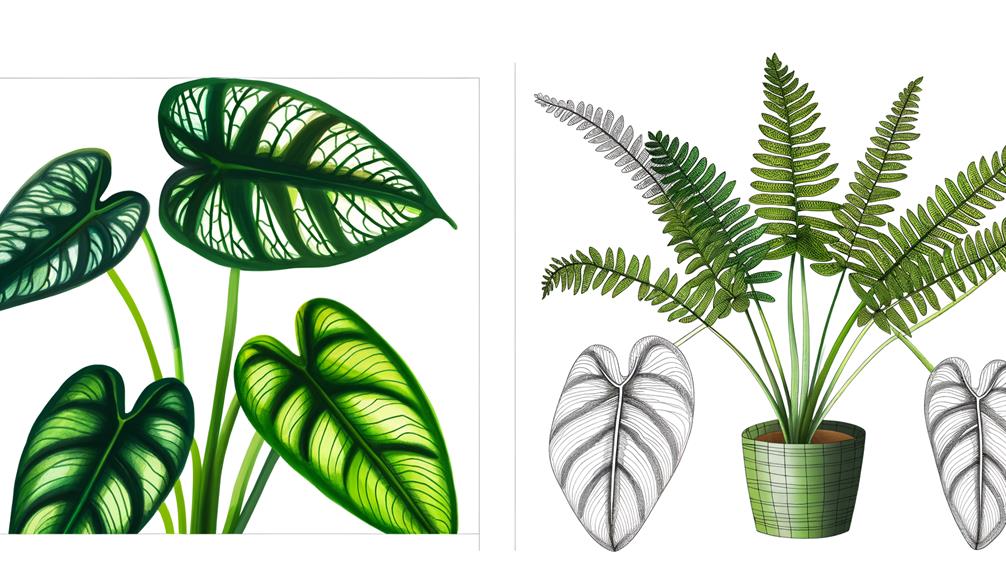
The growth patterns of Philodendron Elegans and Tortum exhibit distinct differences, particularly in their leaf shape and climbing versus spreading tendencies.
Philodendron Elegans typically displays deeply lobed, elongated leaves and adopts a climbing habit, utilizing aerial roots to anchor itself to support structures.
In contrast, Philodendron Tortum is characterized by its finely dissected, narrow leaves and tends to exhibit a more spreading growth pattern, often forming a denser, bushier appearance.
Leaf Shape Differences
Philodendron Elegans and Philodendron Tortum exhibit distinct leaf shape differences, characterized by the intricately lobed, pinnate forms of Elegans compared to the elongated, deeply incised foliage of Tortum.
The leaves of Philodendron Elegans are marked by multiple narrow lobes that radiate symmetrically from the central vein, presenting a feathery and dissected appearance. In contrast, Philodendron Tortum’s leaves are more linear, with deep, pronounced cuts that create a skeletal, almost finger-like structure.
These morphological distinctions not only differentiate the two species aesthetically but also influence their physiological adaptations and light-capturing efficiency. The unique leaf architecture of each species underscores their evolutionary divergence, tailored to their respective ecological niches.
Climbing Vs. Spreading
Beyond their distinct leaf morphologies, Elegans and Tortum also exhibit contrasting growth patterns. Elegans adopts a climbing habit that allows it to ascend vertical surfaces, while Tortum tends to spread horizontally, forming a more sprawling, ground-covering growth. This divergence is attributed to their differing stem structures and root systems.
- Philodendron Elegans: Exhibits elongated internodes and aerial roots, enabling it to anchor onto supports.
- Philodendron Tortum: Features shorter internodes, promoting a bushy, lateral spread.
- Support Requirements: Elegans often requires trellises or stakes to facilitate vertical growth, while Tortum thrives in low, open spaces.
- Space Utilization: Elegans is ideal for confined vertical spaces, whereas Tortum is suited for expansive surfaces.
These growth habits profoundly influence their placement and care in horticultural settings.
Light Requirements
Perfect light conditions for both Philodendron Elegans and Philodendron Tortum are necessary, yet subtle differences exist in their specific requirements.
Philodendron Elegans thrives in bright, indirect light, imitating the dappled sunlight it would experience in its native tropical understory environment. Direct sunlight can scorch its leaves, leading to chlorosis.
In contrast, Philodendron Tortum, while also preferring bright, indirect light, shows a higher tolerance for lower light conditions, making it somewhat more adaptable for indoor settings with limited natural light.
Both species experience ideal growth when shielded from harsh direct sunlight, which can cause photodamage.
Hence, understanding these nuanced light preferences is essential for their sustained health and vitality, ensuring each species can display its characteristic foliage and growth patterns effectively.
Watering Needs
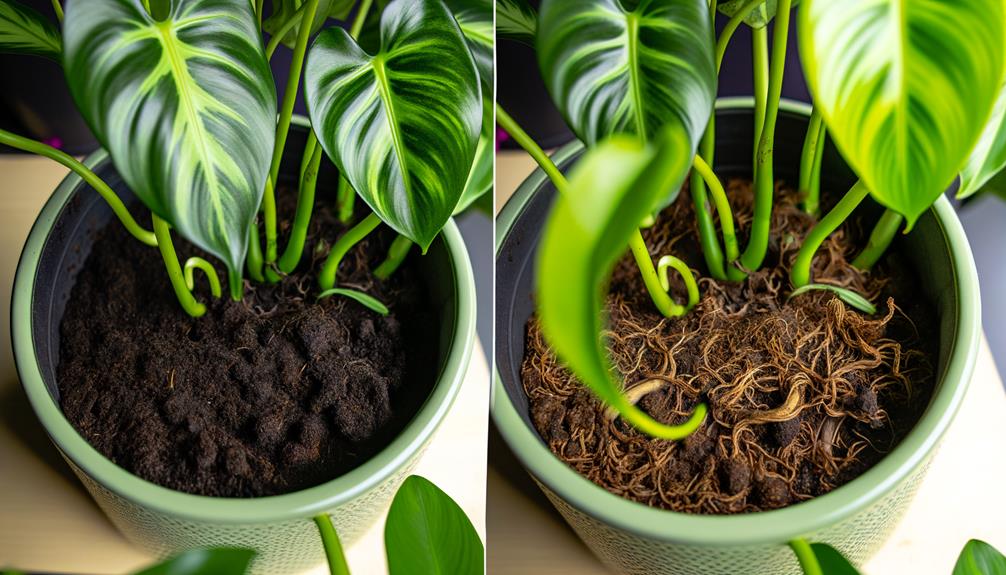
Proper watering is essential for maintaining the health of both Philodendron Elegans and Philodendron Tortum, yet their specific moisture needs exhibit subtle distinctions.
Philodendron Elegans prefers consistently moist soil, whereas Philodendron Tortum benefits from allowing the top layer of soil to dry out slightly between waterings.
Overwatering can lead to root rot in both species, necessitating careful monitoring of soil moisture levels.
- Philodendron Elegans: Requires regular watering to maintain consistent moisture, avoiding waterlogged conditions.
- Philodendron Tortum: Prefers a slight drying period between waterings to prevent root rot.
- Humidity: Both species thrive in high humidity environments, which aids in maintaining the best hydration levels.
- Water Quality: Utilize filtered or rainwater to avoid chlorine and fluoride, which can be harmful to both plants.
Soil Preferences
While understanding their watering needs is fundamental, selecting the appropriate soil composition for Philodendron Elegans and Philodendron Tortum is equally critical to achieve ideal growth and health.
Philodendron Elegans thrives in a well-draining, aroid mix enriched with organic matter, such as sphagnum peat moss, perlite, and orchid bark. This mixture provides adequate aeration and moisture retention, preventing root rot.
In contrast, Philodendron Tortum prefers a more porous substrate with higher drainage capacity. Incorporating components like coarse sand, charcoal, and bark chips into the soil enhances its drainage properties, thereby emulating the plant’s natural epiphytic habitat.
Both species benefit from slightly acidic to neutral pH levels, promoting the best nutrient uptake and vigorous growth.
Temperature Tolerance
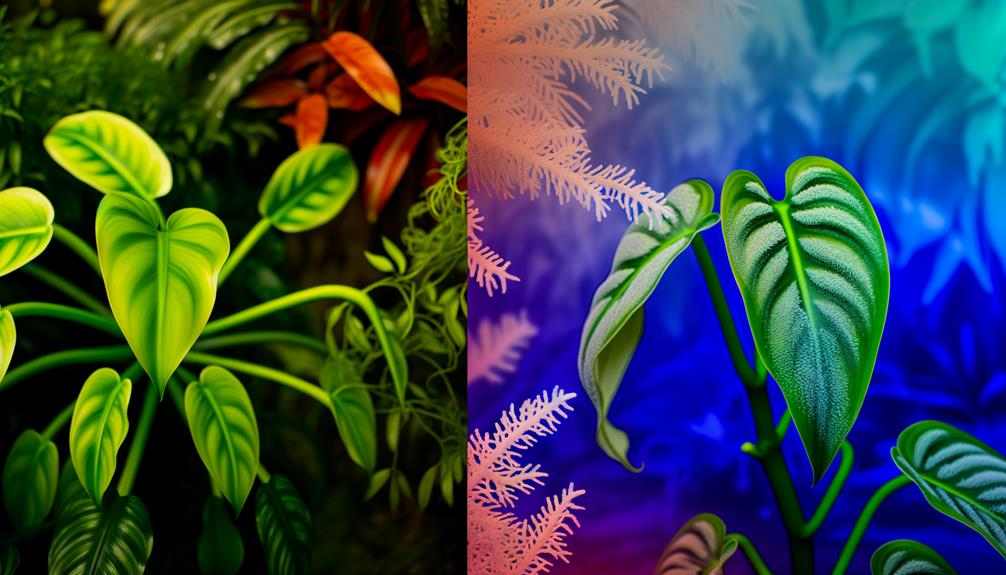
Temperature tolerance is a critical factor influencing the growth and health of Philodendron Elegans and Philodendron Tortum, with both species exhibiting ideal growth in a temperature range of 65-80°F (18-27°C).
However, each species displays unique responses to temperature variations:
- Philodendron Elegans: Tolerates slight temperature drops, but prolonged exposure below 60°F (15°C) can inhibit growth.
- Philodendron Tortum: More sensitive to cold, showing stress symptoms below 65°F (18°C).
- Heat Tolerance: Both species can endure short periods of higher temperatures, but sustained exposure above 85°F (29°C) may lead to leaf scorching.
- Temperature Fluctuations: Sudden changes can negatively affect both species, causing leaf yellowing and reduced vitality.
Understanding these nuances guarantees optimal care and thriving plants.
Humidity Needs
Understanding the humidity requirements of Philodendron Elegans and Tortum is essential for optimizing their growth conditions. Both species thrive in high-humidity environments, typically around 60-80%, but exhibit varying sensitivities to fluctuations in ambient moisture levels.
Effective management of humidity can greatly influence their physiological processes, such as transpiration and nutrient uptake, thereby impacting overall plant health and vigor.
Optimal Humidity Levels
Philodendron elegans and Philodendron tortum exhibit distinct optimal humidity requirements, with both species thriving in environments that maintain consistently high moisture levels in the air. These tropical plants, indigenous to rainforests, necessitate particular humidity conditions to ensure best health and growth.
Specifically, Philodendron elegans prefers humidity levels around 70-80%, whereas Philodendron tortum is slightly more adaptable, flourishing in environments with humidity ranging from 60-80%.
To maintain these conditions:
- Use a humidifier: This helps in consistently regulating the air moisture.
- Frequent misting: Light misting can supplement the humidity needs.
- Pebble trays: Place plants on trays filled with water and pebbles.
- Group plants: Clustering plants can naturally increase local humidity.
Understanding these requirements is essential for the successful cultivation of these species.
Humidity for Growth
Achieving ideal growth in Philodendron elegans and Philodendron tortum necessitates precise humidity management, as these species rely heavily on specific atmospheric moisture levels to support their physiological processes. Both species originate from tropical environments, necessitating high humidity levels for best growth and health.
Philodendron elegans requires consistently higher humidity, ideally between 60-80%, to prevent leaf desiccation and promote robust foliage. In contrast, Philodendron tortum is slightly more tolerant but still thrives best in 50-70% humidity, ensuring its delicate, pinnate leaves remain vibrant and turgid.
| Species | Optimal Humidity (%) | Tolerance Range (%) |
|---|---|---|
| Philodendron elegans | 60-80 | 50-90 |
| Philodendron tortum | 50-70 | 40-80 |
Understanding these requirements is pivotal for successful cultivation.
Managing Humidity Levels
Maintaining ideal humidity levels for Philodendron elegans and Philodendron tortum involves employing various techniques such as humidifiers, pebble trays, and consistent misting to replicate their native tropical conditions. These species flourish in environments with humidity levels between 60% and 80%.
The following methods can help achieve these conditions:
- Humidifiers: Utilizing a humidifier maintains a stable moisture level, essential for avoiding leaf desiccation.
- Pebble Trays: Placing pots on trays filled with water and pebbles increases ambient humidity through evaporation.
- Misting: Regularly misting the foliage helps to mimic natural dew, improving leaf hydration.
- Grouping Plants: Positioning multiple plants together creates a micro-environment with elevated humidity through transpiration.
Such practices guarantee a thriving environment for both Philodendron elegans and Philodendron tortum.
Fertilizing Tips

Understanding the distinct nutritional needs of Philodendron Elegans and Tortum is essential for optimizing their growth through proper fertilization.
Philodendron Elegans thrives with a balanced 20-20-20 NPK (nitrogen, phosphorus, potassium) fertilizer applied bi-monthly during the growing season. This ratio supports robust foliage and root development.
In contrast, Tortum benefits from a slightly higher phosphorus content, using a 10-20-10 NPK formula, promoting its unique skeletal leaf structure.
Both species prefer slow-release granular fertilizers to avoid nutrient burn and maintain steady nutrient uptake. Additionally, incorporating micronutrients such as magnesium and iron can further enhance their vitality.
It is vital to adjust fertilization frequency during dormancy periods, reducing applications to prevent root stress and nutrient accumulation.
Common Pests
Despite their robust nature, Philodendron Elegans and Tortum are susceptible to several common pests, including spider mites, aphids, and mealybugs, which can compromise their health and aesthetic appeal.
These pests exhibit distinct behaviors and impacts:
- Spider Mites: Tiny arachnids that colonize the undersides of leaves, causing stippling and webbing, leading to chlorosis.
- Aphids: Small, soft-bodied insects that cluster on new growth, excreting honeydew, which attracts sooty mold and stunts growth.
- Mealybugs: Cotton-like masses on stems and leaves, which extract sap, causing leaf yellowing and reduced vigor.
- Scale Insects: Hard-shelled pests that adhere to plant surfaces, secreting a protective covering while siphoning nutrients, leading to weakened plants.
Effective pest management involves regular inspection, proper sanitation, and the application of appropriate biological or chemical controls.
Propagation Methods

Propagation of Philodendron Elegans and Tortum can be effectively achieved through stem cuttings, air layering, or division, each method offering distinct advantages and challenges. Stem cuttings involve excising a segment of the stem, which is then rooted in a suitable medium.
Air layering, a more advanced technique, necessitates wounding a section of the stem and encouraging root formation while still attached to the parent plant. Division is applicable for mature plants with multiple stems or natural offshoots, where individual sections are separated and potted independently.
| Propagation Method | Key Characteristics |
|---|---|
| Stem Cuttings | Simple, rapid root development |
| Air Layering | High success rate, labor-intensive |
| Division | Immediate new plants, limited use |
Each method requires specific conditions to optimize success, tailored to the species’ physiological needs.
Conclusion
To sum up, Philodendron elegans and Philodendron tortum show clear disparities in leaf structure, growth behaviors, and care needs.
Remarkably, Philodendron elegans can reach a height of up to 10 feet in ideal conditions, in contrast to the relatively smaller size of P. tortum.
Both varieties require particular light, water, and humidity levels to flourish.
Recognizing these distinctions helps in cultivating and looking after them correctly, ultimately improving the general health and visual charm of these distinct botanical specimens.


